Every bookseller fields this sort of question every day. Yesterday, I had this statement five times. Yes, five times. Often these requests come when I’m not ready for them, like first thing in the morning when I have finished neither my coffee nor my breakfast. (Why I don’t just eat at home is something I’ve never figured out.) This got me to thinking about all the things we’ve been asked.
Below are some of the requests we’ve gotten over the years:
– A gentleman called early one morning and asked if we sold pornography. I told him, without judgment, that we didn’t. He then asked if I knew where he could buy porn. I said I didn’t know and he asked if I had a phone book. At this point, I politely suggested he find his own phone book.
– Sometimes, in small towns, the local bookstore is where things get dropped off. While it’s nothing to hold an envelope or two, once someone asked if we could hold onto her kittens until Christmas morning. We were assured the kittens would be fine for the three days to their big reveal under the tree as long we kept them in their own room away from our dogs, fed them, cleaned a tiny litter box and played with them. Really? Wow.
– Someone came in and said,”I’m looking for that book that was on that show and is about a girl.” Once we deciphered the sentence we realized the customer was talking about a book she heard on the radio six months ago, and it was The Girl with the Dragon Tattoo.
– Can you mail this book, along with this little package, to someone in prison? Um, not so much.
What are some of the crazy requests you’ve gotten?
Monthly Archives: October 2012
To Be a Better Parent, A Little Duct Tape
Elizabeth Bluemle - October 11, 2012
This woman is TED Talk gold; someone please get her booked. On Tuesday evening, we hosted Vicki Hoefle, author of Duct Tape Parenting: A Less Is More Approach to Raising Respectful, Responsible, & Resilient Kids, and wow, was she fantastic. This was one of our best-received events ever, and that is saying something.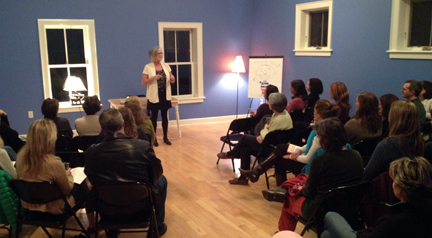
Hoefle gives a very funny, very thoughtful and persuasive presentation on how to quiet down, step back, and let go of the kinds of control that hinder children instead of helping. The goal is to learn who your children are, so you can help them become self-sufficient and able to cope with frustrations, disappointments, and the myriad other challenges life will throw at them.
Hoefle admitted that when her three children were young, she was a tad, well, controlling. She liked to be organized, she dreaded potential chaos, and she wanted things to run smoothly. From the moment the alarm clock rang, she said, she realized she was doing a lot of talking to her children, constantly, all day long. “It’s exhausting for everybody. No wonder kids stop listening,” she said.
The parenting books she turned to then offered tips, timeouts, counting to three, and a lot of other parenting techniques that addressed the symptoms, but not the causes, of the power struggles and communication disjuncture between parents and kids. Finally, she said, “I came to realize that I wanted a life in relationship with my children, not a series of strategies to control their behavior so I could have my life.”
So she started to take stock. “If I really can’t direct every moment, what will happen?” She realized she didn’t have faith in her kids to figure out how to do things, how to cooperate with each other, how to handle situations that go awry.
Because she was such a talker, she literally duct-taped her mouth shut as a reminder to be quiet, to listen and observe from the background. What she found was fascinating. Some things went really well and some things fell apart. By removing herself from the situation, she was better able to assess what skills her children had, how resilient they were, who blamed whom when trouble broke out, how often they came to her to solve problems they could actually solve themselves, how they worked together.
She realized that by being in their business all the time, her message to them had been, “Hey, you guys don’t know how to navigate life. I do, so you are going to sit on the sidelines and watch while I do your life.”
She also realized that she had been something of a hypocrite, by wanting her young ones to achieve standards of behavior that she herself couldn’t live up to. “I’m allowed to say whatever I want to say in whatever tone I wish, to have bad days and be tired and not get things done. I had fewer expectations for myself than I did for them. As I became more quiet and more thoughtful, I realized that I needed to model human interactions. We are their blueprints.”
It isn’t easy to be a duct tape parent, especially if you are an organized, in-control person. “If you let me run your life, I will,” she said. “I need real tangible things to keep me honest. So I always had duct tape on the counter. I empowered the kids, telling them: when I go back to my old ways, go get the duct tape and put a piece on the counter as a reminder that I am overstepping my bounds. I stepped back and gave them a chance. And do you know what happened? I ended up raising five young adults as respectful as any five people I know, because they had an equitable relationship, and a respectful way to communicate.”
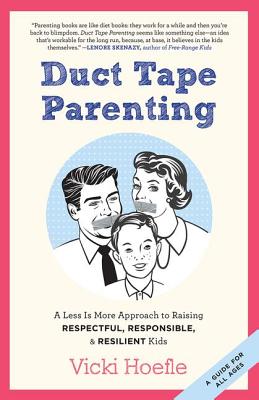 Hoefle has been leading parenting workshops for two decades. She says, those workshops usually start with parents asking, “How do I get my kids to…?” Instead, she suggests, the question we might want to ask is, “What will it take to raise a child who is willing to get up with the alarm clock, who doesn’t react to frustration by hitting their brother, who will invest in their own education?”
Hoefle has been leading parenting workshops for two decades. She says, those workshops usually start with parents asking, “How do I get my kids to…?” Instead, she suggests, the question we might want to ask is, “What will it take to raise a child who is willing to get up with the alarm clock, who doesn’t react to frustration by hitting their brother, who will invest in their own education?”
She talked about a generation of “helicopter-parented” kids, who, upon entering college, find themselves at a loss without adults doing things for them and telling them what to do. “The worst thing for a child is to feel like you need an adult in order to figure out what to do. Then the fear is always there.” Our job is to raise kids who think of themselves as competent, capable; kids who know that their parents believe in them.
One of the most wonderful, touching, and bittersweet parts of Hoefle’s talk was to trace the path of children’s attempts to become self-sufficient and how we unwittingly derail them. When babies learn something new, we applaud and cheer each achievement. And then pretty much the moment they learn to walk and have their hands free and start trying to use those little hands to help out, what’s the first thing we do? Start wailing, “Nooooooo!!! It’s too sharp! That’s too pointy! You’ll break it! You’re going to get hurt!” And so on. And we take over tasks for them. “We talk them out of it. ‘I’m an adult and I can do it faster, so I’ll do it.’ It mucks up a child’s growth and more importantly, it mucks up our relationship with our kids.”
The best thing about Hoefle’s approach is that it doesn’t depend on bribes, threats, or rewards. It’s about mutual respect and real communication. “Parents want to cultivate a relationship with their kids that will last forever. There are subtle shifts they can make in order to create the life they hoped for with their kids.”
It was a wonderful evening, and two parents attended just to raise their hands during the Q&A to thank Hoefle for her role in their lives. Hoefle is a Vermonter, and these women had each attended her workshops, years ago. Both said she had changed the course of their parenting styles, and each was positively tearful with gratitude. It was powerful.
This was one of the liveliest, most fun, and common-sense-filled discussions I’ve had the pleasure of hosting, and there are a LOT of parents into whose hands I wish to press this book.
My only quibble is an editorial one; I miss the hyphens that would seem to belong in the title and subtitle. Duct-Tape Parenting: A Less-Is-More Approach to Raising Respectful, Responsible, & Resilient Kids. Ahh, now everything is perfect.
The Backlist / Midlist Conundrum
Elizabeth Bluemle - October 10, 2012
A friend of mine is in school to become a children’s librarian, and one of her classes has her reading as many Newbery books as possible. I asked her if she had discovered any Newbery favorites she hadn’t been aware of, which got me thinking about my own favorite Newbery titles, some of which I realized I haven’t recommended to a child in too long. Books like I, Juan de Pareja, The Trumpeter of Krakow, Fog Magic, The Moorchild, Roll of Thunder, Hear My Cry, The Great Gilly Hopkins, Rabbit Hill.
With all the noise in the world, I find it is all too easy to let great backlist slide, even Newbery backlist. And I’m a bookseller who deliberately created a bookstore with a deep backlist, and a store culture that is particularly appreciative of the depth and enduring quality of great books that have been around for a while. So I am concerned with the question of how best to keep worthy backlist (and not just Newbery titles, which at least have the stature of the award and ongoing library/school support) alive for young readers today.
I have to say, I love it when publishers smartly repackage backlist classics, as long as the covers are appealing, and serve at least as improvements over the prior versions. Not only can a savvy reissue land on media and consumer radar, it reminds us booksellers about these titles we have long loved and want to remember to recommend. The pop from a repackage probably doesn’t last as long as we might like — the books are quickly subsumed by new titles again — but can have a lasting impact. The Quentin Blake illustrations for the Roald Dahl books, while not always my favorites (I still miss Nancy Eckholm Burkert’s James and the Giant Peach), gave incredible new life to those books. (Alert: This needs to happen with E. Nesbit’s books: bright, lively new covers on these fabulous titles are decades overdue.)
I can’t help but wonder how e-readers will affect children’s and YA midlist and backlist. I assume that most e-book sales are for frontlist or very recent backlist title, with a few exceptions. (I can’t find statistics that break down the sales data in this manner.) As more and more readers access books through e-readers, and as bookstores disappear and library budgets shrink and shelves are weeded to make room for the new, how will readers learn of I, Juan de Pareja? Or even more endangered, non-Newbery backlist wonders like The Second Mrs. Giaconda? Or The Old Man Mad About Drawing? And so many, many more….
So, how do we keep the midlist and backlist books we love foremost in our own minds, as well as in those of our customers, while still sounding the clarion horn for the best of the new books, too?
A Visit with David Shannon
Josie Leavitt - October 9, 2012
This past Sunday we were thrilled to welcome David Shannon to the store for a noon visit. When I left for the 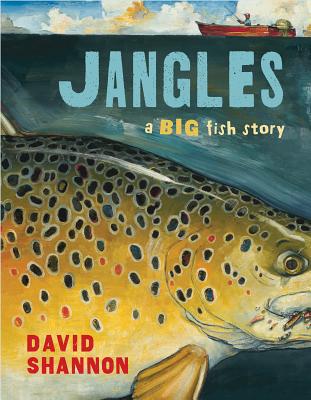 trade show on Tuesday we had about 50 RSVPs. When I came home on Friday that number had swelled to 80, and by the morning of the visit we were topping off at 110. Word seemed to spread like wildfire among folks in our area that he was coming and it was so much fun to see parents as excited as their kids to meet him.
trade show on Tuesday we had about 50 RSVPs. When I came home on Friday that number had swelled to 80, and by the morning of the visit we were topping off at 110. Word seemed to spread like wildfire among folks in our area that he was coming and it was so much fun to see parents as excited as their kids to meet him.
David gave a great show. His reading of his new book, Jangles, was absolutely wonderful. It’s not surprising that a book about a giant fish that is a storyteller would be such a great read aloud by the author. The kids, and there were a lot of them under five, were riveted. David had them in the palm of his hand as he read the story. Little ones were leaning in trying to get closer and parents were still. Being on Lake Champlain made the story of Jangles that much more real to all the kids, and I’m sure the next time they go on the water they will all think of Jangles.
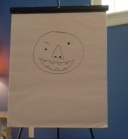 David’s interactions with the kids was great. He moved around the room and this added to the vitality of the event. If I thought the kids were engaged during the story, they were besides themselves when he taught them how to draw the character David, from his Caldecott Honor book, No, David! First you start with the head. It’s a round head, but not a perfectly round one. “Don’t get out a plate and trace his head.”
David’s interactions with the kids was great. He moved around the room and this added to the vitality of the event. If I thought the kids were engaged during the story, they were besides themselves when he taught them how to draw the character David, from his Caldecott Honor book, No, David! First you start with the head. It’s a round head, but not a perfectly round one. “Don’t get out a plate and trace his head.”
The flawed nature of David’s face was really fun for the kids. David Shannon used his own face to show why David’s eyes were uneven: his eyes are uneven. The kids loved this! He turned toward every section of the room and said, “Look, my ears are lined up, but where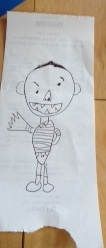 are my eyes?” And sure enough, they were just a little bit uneven. At each step of the drawing process he just got funnier and funnier. There may be no better noise than a roomful of giggling kids when they realize that a grownup is talking about picking noses. One of the older kids was so focused on learning to draw David that he drew a very good rendition of the character on the back of his store receipt.
are my eyes?” And sure enough, they were just a little bit uneven. At each step of the drawing process he just got funnier and funnier. There may be no better noise than a roomful of giggling kids when they realize that a grownup is talking about picking noses. One of the older kids was so focused on learning to draw David that he drew a very good rendition of the character on the back of his store receipt.
Every part of the drawing of David was accompanied by an explanation of why he’s drawn that way. From bad teeth to cowlicks to one nostril being bigger (we’re back to nose-picking here, and the kids loved it) and to not staying in the lines when we draw, everything was about accepting imperfections and embracing them. I loved this.
The signing line was long and no kid got impatient and there were no tears, which totally surprised me. David was very self-sufficient with his signing and needed no help flapping or with post-its, so I continued to sell books and Elizabeth went up and the down the line recommending books to people and that really helped the line stay lively.
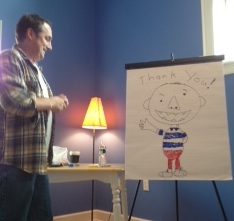 In the end, all we can say is thank you. But of course, David drew it best.
In the end, all we can say is thank you. But of course, David drew it best.
Without Love There Are No Books: Highlights of the Fall NEIBA Conference
Josie Leavitt - October 5, 2012
Once again New England booksellers gathered in Providence, R.I. for our annual conference. The first day was full of conversation, education, and warm greetings from bookselling friends. The show began on Wednesday with the plenary session, that found me unable to take notes as John Sargent, CEO of Macmillan, requested that everything he said was off the record. It’s a pity, because I found his talk and subsequent Q&A to be quite interesting, and sadly with my middle-aged memory and lack of notes, I can recall very little of it, which I’m sure makes him quite pleased. I can say, that I found him to be quite engaging. At one point, he hooked his thumbs on his jean’s belt loops and looked very much like a cowboy about to swing the double doors of the saloon open and brace for a fight.
The workshops that day were extremely informative. The Social Media session had most of the participants leaving somewhat overwhelmed yet galvanized to just do more. My biggest takeaway was to be authentic and work hard to find the Flying Pig voice. Sadly, this means, and this was supported by all the panelists, that only or two people should be updating the Facebook page. So, more work for me and Elizabeth, but a lively Facebook page seems to be a critical thing for a 21st-century store’s success. Many spoke about using Twitter. I’m sorry, I know many folks love Twitter, but I know what my days look like and there just isn’t room for tweeting.
The publishers in the room all said that bookstores should “like” as many authors as they can (and authors they actually like) and then tag the authors and publishers in any posts that include that author. This produces a chain effect of notification that goes through the publishing company from the author to the editor to the publicist, etc. And this can only help a bookstore.
The second session was Staying on the Publisher’s Radar. This session supported the Facebook tagging comment. The best way to make sure publishers notice you and your store is the let them know you’re reading and enjoying their books. This is so simple. It’s not enough to get a galley, love it, order books and put up a shelftalker in your store. The publishers, especially the editors who sit in offices many stories above the ground, love to hear what booksellers think of their books. The more contact you can have with them, the more galleys you’ll get and the more they’ll think of you when other similar books come out.
One point they made repeatedly was to nominate favorite books for the IndieNext list. This was huge, and not something I do very often. Wendy Sheanin of Simon & Schuster had a great idea: write your store shelftalker after you read the book, regardless of when it’s coming out. Then send in your shelftalker to the publicist, your sales rep, and then send it along to Indiebound. Brilliant. And simple.
The Thursday morning breakfast was unbelievably good. All day, that’s practically all anyone was talking about. James Dashner set the tone by being funny and talking about how books saved him and shaped him. He was like me at 12, reading everything by Stephen King. His new book, Infinity Ring #1, is for middle grade kids and he says it combines his love of history and time travel. Kids should really love this.
James was followed by Dennis Lehane who was promoting his new book Live By Night. I have to confess, I love Dennis Lehane. I have loved his books since the Prayers for Rain came out. I was lucky enough to be seated at his table and was surprised at how lovely and accessible he is. He looked like one of his characters: white t-shirt, hoodie, and a sport coat. He was hilarious, funny enough to be a stand up, and he gave 10 reasons that he became a writer. They ranged from his massive family telling stories and lies because folks were loose with the truth to make a better story. What he said that resonated the most with a room of booksellers was: bookstores and libraries are the reasons he became a writer. “Libraries say that you matter just as much as anyone else. Books have the power to give voice to the voiceless and that you matter.” I doubt there was a person in the room who felt differently.
Lisa Genova began by swearing and saying, “Who organized the lineup?” She had no reason to worry about her spot in the lineup – she was great. Her new book, Love, Anthony, is about autism and she felt enormous responsibility to tell the truth about it. Her nephew is autistic and it was very important for her to remind readers that autistic kids are still worthy of our dreams. She did not want to write this book, but the book was ready for her and she wrote it. She shared some laughs with Dennis about when her Boston accent comes roaring back, and it was very funny to see. I loved that she told us she writes at her local Starbucks which is in a Stop and Shop, so she’s been writing in the produce section for years.
Junot Diaz, who was there to talk about his short story collection, This is How You Lose Her, brought the house down. He swears like a sailor and anyone who drops the F-bomb at nine in the morning is my kind of guy. He started off by saying, “That introduction was the shit.” And off we were. All the authors were so funny this year, and that was such a lovely way to start off the day. Junot spoke about the enormous amount of love that goes into books. “Without love there are no books.” There is faith and trust along the journey to get a book into someone’s hands. He grew up in a house without books. His immigrant family demanded that he work, so at 10 he got a paper route and would often read the paper. It was then that he saw a classified ad for FREE BOOKS. He called, and tried to figure out how to get these books that a woman thought were worthy of being passed on, not thrown out. It was the one time in his life that everything worked out: his scary-crazy brother helped, the shopping carts they borrowed from the store weren’t confiscated before he got the books home, and he got the books. There was superb coordination of love for him to get those books. We were laughing and wiping away tears.
This was a metaphor for what we as booksellers and publishers do. It’s all about love. And that’s a great reminder and lovely way to start the day.
The Books You Cannot Put Down
Elizabeth Bluemle - October 4, 2012
We booksellers read a LOT, wildly skewing the national reading average. Anyone reading ShelfTalker is very likely a member of that same club. We are all so happily accustomed to reading really good books, well written and well told. With standards that are high to begin with, it is a rare treat to come across books that surprise us with their freshness or unusual point of view, or that are told so compellingly that we just don’t want to put them down. Don’t you just love those books?!
I felt that way about Grace Lin’s Starry River of the Sky.  A companion book to the Newbery Honor book Where the Mountain Meets the Moon, this one absolutely can stand on its own, although the experience is richer if you’ve read both.
A companion book to the Newbery Honor book Where the Mountain Meets the Moon, this one absolutely can stand on its own, although the experience is richer if you’ve read both.
Here, a runaway boy has stowed himself in a wine vendor’s cart, only to be discovered, hauled out, and left behind in a tiny village called Clear Sky, where an innkeeper agrees to take him on as a worker. Rendi, the boy, is unhappy with this arrangement, but until some other form of transportation arrives, he’s stuck; Clear Sky is in the middle of nowhere, with only a giant flat rock stretching into the dry land as far as the eye can see.
The magic in this story lies in its light touch, its humor, the sweet quirkiness of the characters, the marvelous Chinese myths and legends woven throughout, and most of all, in the river of goodness that radiates from it. Lin is a kind writer, not afraid to address sorrow and anger and grief, but always in a way that ultimately brings out the light and compassion in her characters.
I found I didn’t want to put this book down. It was such a fresh drink, full of strangeness and delight.
Is there a book this year you’ve felt that way about, the kind of book you always know the location of in your house or car or store, the kind your fingers itch unconsciously to pick back up when you’ve had to put it down?
It’s Fall Conference Time
Josie Leavitt - October 3, 2012
It’s that time of year again when all the regional trade associations host their annual conferences. I belong to the New England Independent Bookselling Association and our trade show starts today in Providence, R.I.
This year NEIBA is trying something new with the schedule. There are educational sessions all day Wednesday and the show floor is only open on Thursday. I think this makes sense. It’s always a challenge to try to cover the show floor while there are educational sessions at the same time. This way, buyers have time to focus just on on looking at books and feel divided about how to spend their time.
The meet and greet cocktail party on Wednesday evening is always a great way to see a lot of authors and illustrators in one place. The only thing I miss about this is that it’s not giving us a sneak peek of the show floor like last year. This year the party is only in the rotunda, so the show floor isn’t even available. I actually got a lot of business done last year at the party by talking with my reps and making orders. And I liked being able to scope out where I wanted to go first the next morning.
What I don’t understand is how the trade show floor is open the middle day of the conference and then on the last day, Friday, there is the annual meeting, two educational sessions and the awards lunch. This just feels to me like a half day of school that begs to cut. The awards lunch just never seems to work out for me. Either it’s the first day and I don’t stay over the night before to save money and short of leaving at six in the morning, I’ve never made it. The children’s dinner, which I’ve never missed, is Thursday night, so folks who might not want to stay for the Friday programming still have to pay to stay overnight unless they like heading for home at 10 at night.
The programming this year is quite good. The author breakfast on Thursday is chock full, with James Dashner, Junot Diaz, Lisa Genova and Dennis Lehane. This is a great line-up and one I will happily wake up for. The children’s dinner is equally good with Katherine Applegate and Michael Grant, Scott Nash and David Shannon. I love these meals with authors and illustrators because I’m always surprisingly moved and they’re often funny.
So, I will report back on Friday about how the show has been.
A Different Kind of Community Outreach
Josie Leavitt - October 1, 2012
When I’m not working at the bookstore, I’m a professional stand-up comic. I also have been teaching stand-up for seven years at our regional theatre, The Flynn Center, in Burlington. Until last spring, my teaching has been confined to the theatre arts program. In April I started teaching stand-up at the women’s prison. The success of that led me to the work in the men’s prison this fall.
I know there are people out there who think prisoners are in jail for very good reasons and admittedly, some of these students have done some fairly heinous things and therefore might not be deserving of what’s known as “enrichment.” I work through the Community High School of Vermont, which is the country’s only accredited high school within the prison system. Inmates take classes and can graduate with a full high school diploma and not just a GED. So, the students I work with are all enrolled in the high school and are generally among the better behaving inmates in the prison.
For the past six weeks I have taught seven men how to write, edit and perform stand-up comedy. We had our show on Thursday. I’ve learned that it doesn’t much matter if you’re in prison, or in a comedy club — first-time stand-ups are a nervous bunch. They were pacing, muttering and kind of bouncing off the walls. The head of the school made percolated coffee which thrilled the audience as well as the comics.
Working with a prison population will do nothing for the bookstore in terms of increased sales from the prison system, or even get us new shoppers, but there was something so satisfying and energizing about it, that I feel like a better bookseller because of it.
The men wrote me a thank-you card that said: In a world of order, thanks for the chaos. That still makes me laugh.
